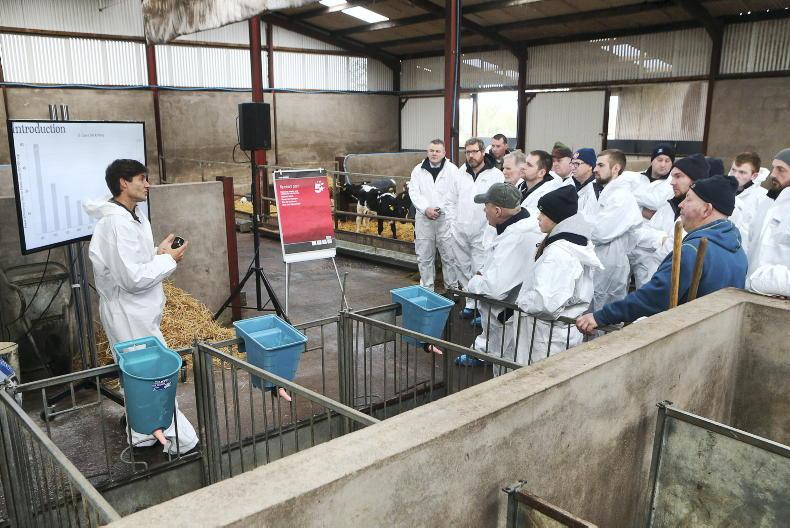A leading livestock researcher from Spain described his ideal calf rearing procedure at a dairy event organised by local feed company Thompsons last week.
Speaking in Coleraine, Dr Alex Bach from the Catalan Institution for Research and Advanced Studies said the first feed of colostrum should be given within four to six hours after calving.
“It is better to feed a little amount more often, than one huge dose of colostrum. If she only takes two litres to start with, just give her a second dose a few hours later,” he said.
When it comes to milk replacer, Bach recommends feeding six litres at a 15% dilution rate with 900g of powder.
The pre-weaning target for daily liveweight gain is 1kg and Bach said this level of milk replacer should achieve 700g of daily gain in healthy calves.
“You only need to get 300g more of daily gain through the solid feed. You are going to feed pelleted starter ration at 20% protein, and you also feed chopped straw.
“At 70 days you remove milk, and you continue to feed concentrates and straw at a rate of 95% concentrates to 5% straw,” he said.
This ratio of feeding is maintained until four months of age, when the amount of forage in the diet can increase to “10% to 15% maximum”.
“At six months, you have an animal with a complete rumen so you can start introducing wet forages like grass silage,” he said.
Post weaning
Several speakers at the event said a common issue on dairy farms is that calves become lower priority stock once they are off milk and growth rates subsequently decline after weaning.
Bach said overfeeding milk replacer before weaning can lead to lower concentrate intakes and this affects performance once milk is removed from the diet.
He suggested liveweight gain should increase after weaning to sit at 1.2kg/day until around 155 days of age, before going back to 1kg/day up until six months of age.
To be able to hit these targets, regular weighing of calves is crucial said Bach.
“It is very important that you have scales to measure weights. If you do not, then you are blind and you will not have good quality heifers,” he maintained.
Useful benchmarks
It was suggested by dairy vet Dr Dan Humphries that when assessing the performance of livestock, average figures for a group is not the most useful benchmark available.
He argued that average figures often mask poorer performers and these are the animals that need targeted if overall herd performance is to improve.
“Averages don’t do anyone any favours. We should look at percentages. For example, what percentage of our animals calve by 25 months? It should be in excess of 90%,” Humphries said.
Another measure of productivity is the percentage of heifer calves that make it to their second lactation, as this is when cows cover their rearing costs and become profitable.
“That can expose some cracks in the system when you realise how many animals had a cost they never paid back. It has both a financial and sustainability angle. Those two years of growth are an environmental impact where we don’t get a reward,” Humphries said.
A useful first step in addressing replacement costs and overall profitability is to keep a record of reasons why cows leave the herd.
“If it was a manufacturing business and there was a problem with things breaking, the first thing you would want to do is work out where they are breaking and why,” Humphries said.






 This is a subscriber-only article
This is a subscriber-only article











SHARING OPTIONS: